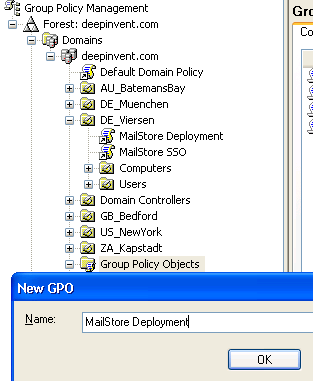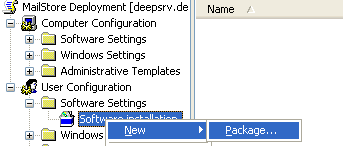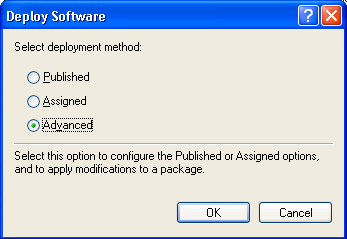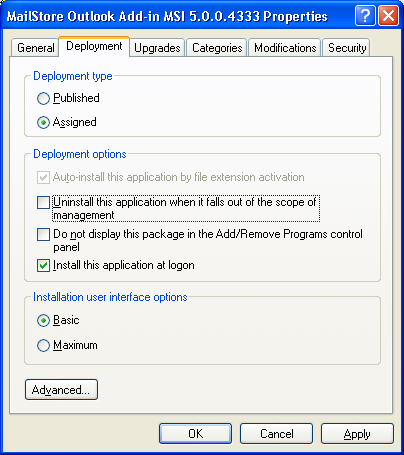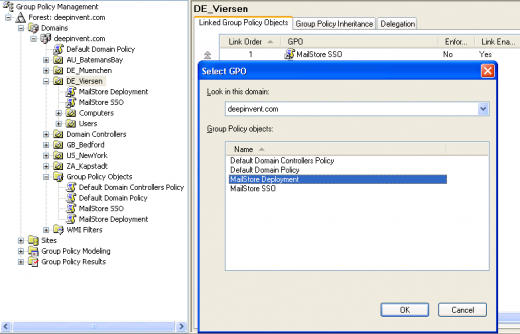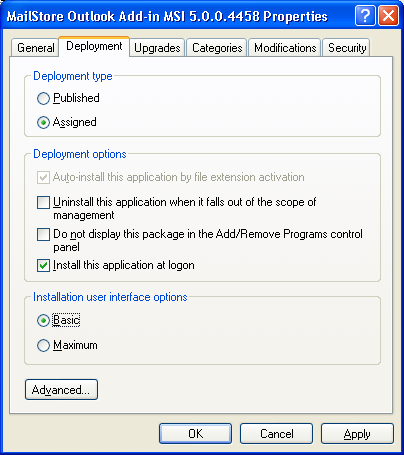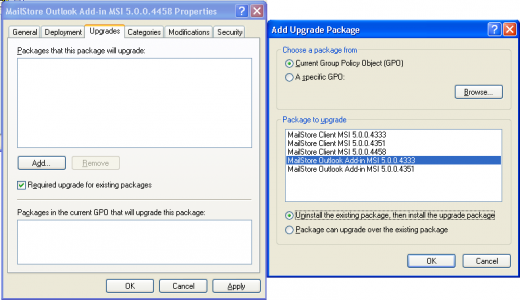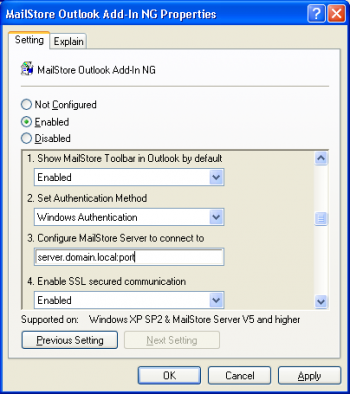Difference between revisions of "MailStore Outlook Add-in Deployment"
| [unchecked revision] | [unchecked revision] |
| Line 7: | Line 7: | ||
Example: Setting up distribution in Windows Server 2003 | Example: Setting up distribution in Windows Server 2003 | ||
| − | * Download MailStore Outlook Add-in in .msi format from the MailStore website | + | * Download MailStore Outlook Add-in in .msi format from the MailStore website http://www.mailstore.com/de/mailstore-server-download.aspx |
* Save the download in a directory on the server that is shared and accessible to all users of the domain. | * Save the download in a directory on the server that is shared and accessible to all users of the domain. | ||
* Open the Group Policy Management Console. If this is not available, download the installation routine under http://www.mailstore.com/?gpmc. | * Open the Group Policy Management Console. If this is not available, download the installation routine under http://www.mailstore.com/?gpmc. | ||
* Install the console. | * Install the console. | ||
* Open the group policy management console of the Windows server | * Open the group policy management console of the Windows server | ||
| − | * Right-click on the administrative folder Group Policy Objects, select New and create a new group policy object called MailStore Outlook Add-in Deployment. | + | * Right-click on the administrative folder ''Group Policy Objects'', select ''New'' and create a new group policy object called ''MailStore Outlook Add-in Deployment''. |
*: [[File:Tech_client_01.png|center]] | *: [[File:Tech_client_01.png|center]] | ||
| − | * Highlight the new object and click on Edit. Expand User Configuration and Software Settings and right-click on Software installation. Select New and Package... | + | * Highlight the new object and click on ''Edit''. Expand User Configuration and Software Settings and right-click on ''Software installation''. Select ''New'' and ''Package...'' |
*: [[File:tech_client_02.png|center]] | *: [[File:tech_client_02.png|center]] | ||
| − | * Select | + | * Select an MSI package. Please keep in mind that the path for the file must be entered in UNC notation (e.g. \\Server\Setup\MailStoreOutlookAddinSetup...) and that the users of the domain need to have read-access to this directory share. |
| − | * In the following dialog window, select Advanced and click OK. | + | * In the following dialog window, select ''Advanced'' and click ''OK''. |
*: [[File:Tech_client_03.png|center]] | *: [[File:Tech_client_03.png|center]] | ||
* On the next screen, please select the settings as shown below: | * On the next screen, please select the settings as shown below: | ||
*: [[File:Tech_client_04_en.png|center]] | *: [[File:Tech_client_04_en.png|center]] | ||
| − | * Click on OK to confirm all settings. The group policy should look similar to the one shown below: | + | * Click on ''OK'' to confirm all settings. The group policy should look similar to the one shown below: |
*: [[File:Tech_client_05_en.png|center|520px]] | *: [[File:Tech_client_05_en.png|center|520px]] | ||
* Close the group policy editor. The group policy is now configured and can be linked to the corresponding user objects. Linking is done using organizational units (OU). | * Close the group policy editor. The group policy is now configured and can be linked to the corresponding user objects. Linking is done using organizational units (OU). | ||
| − | * Highlight the organizational unit (OU) which contains the desired user objects, right-click on the OU (DE_Viersen in the example below) and select the option Link an existing GPO. In the dialog window Select GPO, highlight MailStore Outlook Add-in Deployment and click on OK. | + | * Highlight the organizational unit (OU) which contains the desired user objects, right-click on the OU (DE_Viersen in the example below) and select the option ''Link an existing GPO''. In the dialog window Select GPO, highlight ''MailStore Outlook Add-in Deployment'' and click on ''OK''. |
*: [[File:Tech_client_06.png|center|520px]] | *: [[File:Tech_client_06.png|center|520px]] | ||
* The group policy is now available and becomes active the next time users log on to the Windows client. | * The group policy is now available and becomes active the next time users log on to the Windows client. | ||
| Line 31: | Line 31: | ||
With group policies, the MailStore Outlook Add-in software on the user machines can be updated automatically. To edit an existing MailStore Outlook Add-in deployment group policy so that an automatic update of the clients can be performed, please proceed as follows: | With group policies, the MailStore Outlook Add-in software on the user machines can be updated automatically. To edit an existing MailStore Outlook Add-in deployment group policy so that an automatic update of the clients can be performed, please proceed as follows: | ||
| − | * Open the existing group policy MailStore Outlook Add-in Deployment. Create a new package and select the updated MailStore Outlook Add-in MSI file. In the following dialog window, select Advanced and click on OK. Please select the settings as shown below: | + | * Open the existing group policy ''MailStore Outlook Add-in Deployment''. Create a new package and select the updated MailStore Outlook Add-in MSI file. In the following dialog window, select ''Advanced'' and click on ''OK''. Please select the settings as shown below: |
*: [[File:Tech_client_07_en.png|center]] | *: [[File:Tech_client_07_en.png|center]] | ||
| − | * In the Updates tab, click on Add and select the software to be updated. Choose the settings as shown below and click on OK and confirm by clicking on OK again. | + | * In the ''Updates''-tab, click on ''Add'' and select the software to be updated. Choose the settings as shown below and click on ''OK'' and confirm by clicking on ''OK'' again. |
*: [[File:Tech_client_08_en.png|center|520px]] | *: [[File:Tech_client_08_en.png|center|520px]] | ||
* The group policy should look similar to the one in the following graphic: | * The group policy should look similar to the one in the following graphic: | ||
| Line 53: | Line 53: | ||
'''Configuring MailStore Outlook Add-In''' | '''Configuring MailStore Outlook Add-In''' | ||
| − | With the new MailStore Outlook Add-in, you can configure the way the add-in contacts the MailStore | + | With the new MailStore Outlook Add-in, you can configure the way the add-in contacts the MailStore Server. |
[[File:ms_Outlook_Add-In_settings_01_en.png|center|350px]] | [[File:ms_Outlook_Add-In_settings_01_en.png|center|350px]] | ||
Revision as of 15:52, 15 October 2010
Using a software distribution system, MailStore Outlook Add-in can be distributed among the users' computers automatically. To be able to do so, the distribution system must be able to execute MailStore Outlook Add-in's setup program without requiring any input or confirmations.
Using Group Policies
Installation
In addition to being installed manually, MailStore Outlook Add-in can also be distributed to all user computers using Active Directory. Once the distribution process is set up successfully, MailStore Outlook Add-in will be installed automatically when the user logs on. This process runs in the background and requires no action on part of the user. Immediately after the distribution, the user can use the MailStore Outlook Add-in as usual.
Example: Setting up distribution in Windows Server 2003
- Download MailStore Outlook Add-in in .msi format from the MailStore website http://www.mailstore.com/de/mailstore-server-download.aspx
- Save the download in a directory on the server that is shared and accessible to all users of the domain.
- Open the Group Policy Management Console. If this is not available, download the installation routine under http://www.mailstore.com/?gpmc.
- Install the console.
- Open the group policy management console of the Windows server
- Right-click on the administrative folder Group Policy Objects, select New and create a new group policy object called MailStore Outlook Add-in Deployment.
- Highlight the new object and click on Edit. Expand User Configuration and Software Settings and right-click on Software installation. Select New and Package...
- Select an MSI package. Please keep in mind that the path for the file must be entered in UNC notation (e.g. \\Server\Setup\MailStoreOutlookAddinSetup...) and that the users of the domain need to have read-access to this directory share.
- In the following dialog window, select Advanced and click OK.
- On the next screen, please select the settings as shown below:
- Click on OK to confirm all settings. The group policy should look similar to the one shown below:
- Close the group policy editor. The group policy is now configured and can be linked to the corresponding user objects. Linking is done using organizational units (OU).
- Highlight the organizational unit (OU) which contains the desired user objects, right-click on the OU (DE_Viersen in the example below) and select the option Link an existing GPO. In the dialog window Select GPO, highlight MailStore Outlook Add-in Deployment and click on OK.
- The group policy is now available and becomes active the next time users log on to the Windows client.
Updating
With group policies, the MailStore Outlook Add-in software on the user machines can be updated automatically. To edit an existing MailStore Outlook Add-in deployment group policy so that an automatic update of the clients can be performed, please proceed as follows:
- Open the existing group policy MailStore Outlook Add-in Deployment. Create a new package and select the updated MailStore Outlook Add-in MSI file. In the following dialog window, select Advanced and click on OK. Please select the settings as shown below:
- In the Updates-tab, click on Add and select the software to be updated. Choose the settings as shown below and click on OK and confirm by clicking on OK again.
- The group policy should look similar to the one in the following graphic:
MailStore Outlook Add-in will be updated the next time users log on to their Windows workstations.
To avoid complications when installing software using group policies, the following settings for the MailStore Outlook Add-in Deployment group policy should be adjusted as well:
- Activate Computer Configuration/Administrative Templates/System/Scripts\Run logon scripts synchronously
- Activate Configuration/Administrative Templates/System/Logon\Always wait for the network at computer startup and logon
Configuration
Installation of Group Policy Template
Configuring MailStore Outlook Add-In
With the new MailStore Outlook Add-in, you can configure the way the add-in contacts the MailStore Server.
- Show MailStore Toolbar in Outlook
- Here you define, whether the MailStore Outlook Add-in is shown or hidden by default. Possible values are activate or deactivate.
- Choose authentication method
- Here you define, which authentication method should be used for logins.
- Possible values are users choice, Default Authentication or Windows Authentication. Windows Authentication is only available in Active Directory environments.
- Address of MailStore Server
- Here you set up the hostname or IP-address of your MailStore Server to which the clients should connect. Should MailStore Web Access configured to listen on other than the default ports (8461/8462), you need to add the port information to the hostname or IP-Address in the format :port.
- Use SSL secured connection
- If you activate this option, the communication between the MailStore Outlook Add-in and your MailStore Server is SSL encrypted. Possible values are activated or deactivated.
Note: If you activate this option, no unencrypted communication is possible with you MailStore Server. You need to make sure, that encrypted communication to you MailStore Server is configured properly.
- If you activate this option, the communication between the MailStore Outlook Add-in and your MailStore Server is SSL encrypted. Possible values are activated or deactivated.
Without using Group Policies
Currently there is no single setup file available for the MailStore Outlook Add-in, which can be deployed without group policies.
As the MailStore Outlook Add-in is shipped together with the MailStore Client Installation, you can follow the instructions for deploying MailStore Client without group policies.
